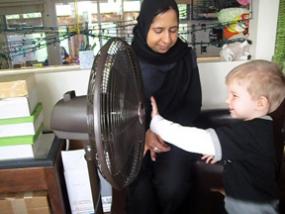Owen's First Fan

Imagine a child’s joy at discovering a constant, localized wind, aka a fan. Watch Owen explore this controlled event to figure out the boundaries and intensity of its effects. He feels the wind on his face and realizes the source of this invisible force. At first he approaches the front of the fan with one hand, palm parallel to the grill barrier over the blades. As the cool force hits his palm, he smiles at his teacher, communicating his joy. He places his hand very near the grill but decides not to touch the grill, as though he understands that the wind is something that comes from the grill but is not the grill itself. He touches the grill to move it slightly, as if to confirm that the feeling of the wind will be different than the feeling of the grill.
What to do next? Owen brings both hands in front of the grill, palms parallel with the plane of the fan, fingers splayed outward. Perhaps he seeks to test the scope of the wind - how wide it might be. One hand at a time would only tell him that the wind blows at that one spot. Two hands tell him that this “one” wind spans at least the distance between his two hands. Again he smiles at the teacher as if he wants to share the joy of learning something about this fan-made wind. Notice how he withdraws his hands, two at once, raising them softly in a backward arch. Could this be an action symbol, a simulation of how wind can blow things back away from its source? This interpretation has some credibility given how he pretends that his entire body is blown backward later in the clip.
The teacher understands that Owen is exploring the force of the wind and decides to bring in another dimension - the sound of the wind. She asks, “What does it sound like?” Before answering, Owen turns his ear parallel to the fan to receive its full force. After a moment he says, “Windy.” Hearing his answer, we can understand that this was a difficult question. Saying “windy” names the event, but it does not describe what windy itself “sounds like.” The answer would be similar to saying, “catty” if asked what a Halloween cat looked like. The answer does not consider the need to use some description other than the wind itself, something that helps the listener associate the sound of the wind with other sounds, such as, “like a locomotive,” a favorite answer when a witness to a tornado is interviewed by the press.
Perhaps Owen enhances the meaning of his answer, “windy” by showing the teacher what strong winds do. He stubbles, deliberately, backwards and falls down. He does this twice again, in different directions, as if to reveal the wideness of the wind. To Owen, the wind is framed (conceptualized) as a force that moves things away. Another child might frame the wind as a flow that cools things; another, as a force that lifts things; another, as a force that keeps things from moving toward the source. Children reveal their own way of framing an event through their actions.
Now Owen returns to stand steady in front of the fan. While his dramatizations of being blown backward were expressive, they do not allow him to explore other events that actually come from the fan. He feels his hair to confirm that it is moving, knowing that hair has no way to move itself. Hair is not like fingers or eyelashes. It must be the wind. He says, “The wind in my hair.” He feels the movement on his scalp, but he cannot see it. He moves his hand a few inches above his head. If he placed his hand directly on his hair, his hand would have stopped the hair’s movement. But by holding his hand an inch away from his scalp, he can determine that the hair is standing up, not lying dormant flat to his head.
The teacher smiles and participates in Owen’s curiosity by saying, “The wind in your hair. I see it moving.” The teacher wants Owen to know the method by which she can “see” something that is invisible. One “sees” the invisible wind by looking for its effects in the movement of things you can see. Owen has no mirror to see what the teacher sees. He holds still, as if to isolate the force that moves his hair. If he were moving at the same time the fan was blowing, it would not be clear that the fan was the cause. He moves his head from one side to another, as if that will augment the feeling of the wind all through his hair. Toward the end of the clip he very subtly raises his eyebrows (00:44) just before he turns to walk off camera. This little action, for some reason, makes one think he has just said to himself, “There is something on my head.” He pats down his hair as he leaves the flow of the fan.
We see in this 46-second clip how a child reveals what he knows and how he frames a new experience. We also see his alternation between exploring the physical event and symbolizing his understanding of the physical event (pretending to be blown backward). Through this combination of testing and representing, representing and testing, children construct their understandings of new events. Teachers can help by letting the children know that we find their explorations and representations interesting and by occasionally bringing in a new dimension to think about (“How does it sound?”) or by making a method of knowing more explicit (“I can see your hair move.”).
